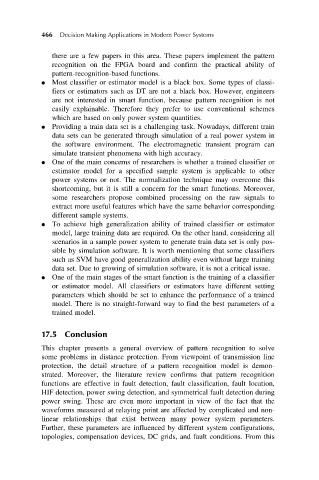Page 506 - Decision Making Applications in Modern Power Systems
P. 506
466 Decision Making Applications in Modern Power Systems
there are a few papers in this area. These papers implement the pattern
recognition on the FPGA board and confirm the practical ability of
pattern-recognition-based functions.
Most classifier or estimator model is a black box. Some types of classi-
fiers or estimators such as DT are not a black box. However, engineers
are not interested in smart function, because pattern recognition is not
easily explainable. Therefore they prefer to use conventional schemes
which are based on only power system quantities.
Providing a train data set is a challenging task. Nowadays, different train
data sets can be generated through simulation of a real power system in
the software environment. The electromagnetic transient program can
simulate transient phenomena with high accuracy.
One of the main concerns of researchers is whether a trained classifier or
estimator model for a specified sample system is applicable to other
power systems or not. The normalization technique may overcome this
shortcoming, but it is still a concern for the smart functions. Moreover,
some researchers propose combined processing on the raw signals to
extract more useful features which have the same behavior corresponding
different sample systems.
To achieve high generalization ability of trained classifier or estimator
model, large training data are required. On the other hand, considering all
scenarios in a sample power system to generate train data set is only pos-
sible by simulation software. It is worth mentioning that some classifiers
such as SVM have good generalization ability even without large training
data set. Due to growing of simulation software, it is not a critical issue.
One of the main stages of the smart function is the training of a classifier
or estimator model. All classifiers or estimators have different setting
parameters which should be set to enhance the performance of a trained
model. There is no straight-forward way to find the best parameters of a
trained model.
17.5 Conclusion
This chapter presents a general overview of pattern recognition to solve
some problems in distance protection. From viewpoint of transmission line
protection, the detail structure of a pattern recognition model is demon-
strated. Moreover, the literature review confirms that pattern recognition
functions are effective in fault detection, fault classification, fault location,
HIF detection, power swing detection, and symmetrical fault detection during
power swing. These are even more important in view of the fact that the
waveforms measured at relaying point are affected by complicated and non-
linear relationships that exist between many power system parameters.
Further, these parameters are influenced by different system configurations,
topologies, compensation devices, DC grids, and fault conditions. From this

